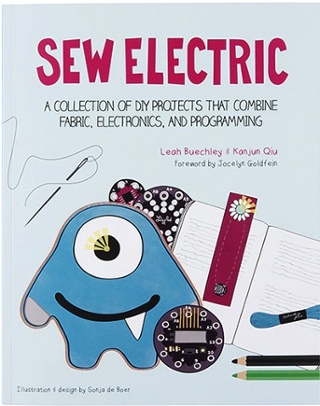Looking for something to inspire future e-craft and e-textile projects? I've put together a list of my top picks over on the SparkFun Education blog.
Image via SparkFun.com
Looking for something to inspire future e-craft and e-textile projects? I've put together a list of my top picks over on the SparkFun Education blog.

Image via SparkFun.com
Check out my new post over on SparkFun Education's blog, which talks about how to create easy to use teaching tools for paper circuit lessons.

Photo by Juan Pena
I've teamed up with my coworker Amanda and a super special guest (my cat Sadie!) to showcase how to build some fun paper circuit cards and e-textile ideas for the upcoming holiday.
Read more over on the SparkFun blog
Last weekend my friend Erin and I attended the first public workshop on paintable electronics/paper computing held by the High-Low Tech group at the MIT Museum. Part of the Cambridge Science Festival, it was a day-long (10am-5pm) demonstration and work session using conductive paints, batteries, and computing components to make interactive paper artworks. When I attended the TEI Conference back in January, I was able to play with the Electronic Popables project by Jie Qi; it is a truly phenomenal example of combining paper engineering/pop up techniques with electronic components and conductive materials. I was so excited to participate in this workshop and try my hand at this new way of combining craft and technology.
Electronic Popables via High-Low Tech
For the first part of the session, Leah Buechley and her graduate students Hannah Perner-Wilson, David Mellis, and Emily Lovell showed us some examples, including a paper piano, light-up flying spaghetti monster painting, and a piece of paper with a bend sensor built in that changed tones as you moved it.

Paper Piano by Hannah Perner-Wilson (image via High-Low Tech)
We then used sticky notes to practice painting conductive paints and started to draw/paint a simple circuit with an LED in it. Getting used to working with the paint was tricky and it took awhile to dry, but after a little practice we were creating interesting designs. We then moved on to making switches and battery holders by painting the conductive paint on pieces of paper that we attached to parts of our circuits.
My first experiments with a painted circuit.
We glued down LEDs and literally painted the traces on top of the leads.

Testing out a circuit. Conductive paint under the brad allowed me to slide it and turn on a LED when I lined up the paths. You can see a few places where I was still learning to use the paint and it got a little messy. The white stickers under the LEDs covered some mistakes/spills that shorted out my lights.

https://www.flickr.com/photos/the_gella/4590345158/in/album-72157623977452522/
Here’s a video of Erin’s circuit, a mix of origami and drawing to make a lily pad design.
After lunch we were given kits that included LEDs, a speaker, a chip pre-programmed with some functions (fading/blinking lights, an input for a switch or sensor, and an output for a speaker) and made more complicated paper circuits. I kept mine simple with some lights, but there were some really creative and interesting results from other participants. Erin made an awesome jukebox that incorporated the painted traces beautifully.

https://www.flickr.com/photos/the_gella/4590345806/in/album-72157623977452522/
The participants were a mix of people who were interested in art, engineering, and science; a few had worked with sewing circuits and some had never worked with electronics at all. It was a lot of fun walking around and seeing all the different ways we used the components to make our projects. Leah and her students were really engaging and helpful and took the time to help each of us troubleshoot our circuits and offer advice and hints on working with the conductive paints.

I had a great time at the workshop and am hoping to purchase some of the paint we used and gather some friends to experiment with it at home. One problem that I was discussing with High-Low Tech student Emily Lovell was the fact that the paint oxidizes and you have to use it before it goes ‘bad’. Right now the paint is sold in fairly large quantities so I would have to do a lot of painting or find a lot of people to paint with me. Another issue was that the paint tended to separate, so the bottles we were using to apply the paint with needed to be shaken frequently or the traces would not work as well.
Working with electronics and paper made me realize how much improvisation goes into my soft circuit projects. Since the connections were painted, it meant I had to plan and sketch out my ideas in advance. Most of my sewing projects are pretty flexible/adaptable because I can take out a seam here or there, and thus I sort of make them up as I go along. It was an interesting exploration and I can’t wait to see more from the High-Low Tech as they develop the Teardrop paper computing kit and components further.
Here are some more pictures and videos:
http://www.flickr.com/apps/slideshow/show.swf?v=71649There are also some photos of the workshop on Hannah Perner-Wilson’s flickr account.